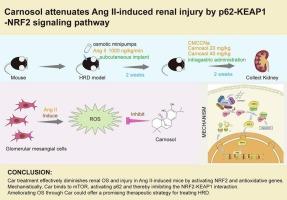Carnosol通过p62-KEAP1-NRF2信号通路减轻Ang ii诱导的肾损伤
IF 3.4
3区 医学
Q2 PHARMACOLOGY & PHARMACY
引用次数: 0
摘要
高血压引起许多并发症,包括高血压肾病(HRD)。最近的研究强调了氧化还原稳态在高血压相关肾脏疾病中的重要性。Carnosol (Car)已被确定为治疗其他疾病的有效抗氧化剂。然而,它在人力资源开发中的作用仍然不确定。本研究评价了Car对HRD的治疗作用,并探讨了其药理机制。Car (40 mg/kg)在体外和体内均能有效改善血管紧张素II (Ang II)诱导的肾损伤和氧化应激(OS)。在机制上,Car通过与mTOR的相互作用促进p62的磷酸化,导致KEAP1的降解,NRF2的释放,以及随后抗氧化基因的上调。阻断mTORC1可消除car诱导的p62活化及其抗氧化功能。综上所述,我们的研究表明,Car激活p62-KEAP1-NRF2通路,减轻Ang II引起的肾损伤和OS。因此,Car可能成为预防和治疗Ang ii诱导的肾损伤的有希望的候选药物。本文章由计算机程序翻译,如有差异,请以英文原文为准。

Carnosol attenuates Ang II-induced renal injury by p62-KEAP1-NRF2 signaling pathway
Hypertension engenders numerous complications, including hypertensive renal disease (HRD). Recent studies have underscored the significance of redox homeostasis in hypertension-associated kidney disorders. Carnosol (Car) has been identified as a potent antioxidant in other diseases. Nevertheless, its role in HRD remains uncertain. This research evaluated the therapeutic impact of Car on HRD and explored its pharmacological mechanism. Car (40 mg/kg) effectively ameliorated kidney injury and oxidative stress (OS) induced by angiotensin II (Ang II) both in vitro and in vivo. Mechanistically, Car facilitates the phosphorylation of p62 through its interaction with mTOR, leading to the degradation of KEAP1, the release of NRF2, and the subsequent upregulation of antioxidant genes. Blocking mTORC1 eliminated Car-induced p62 activation and its antioxidant functions. In summary, our research has demonstrated that Car activates the p62-KEAP1-NRF2 pathway to alleviate the kidney injury and OS caused by Ang II. Consequently, Car may emerge as a promising candidate for the prevention and treatment of Ang II-induced kidney injury.
求助全文
通过发布文献求助,成功后即可免费获取论文全文。
去求助
来源期刊
CiteScore
6.80
自引率
2.60%
发文量
309
审稿时长
32 days
期刊介绍:
Toxicology and Applied Pharmacology publishes original scientific research of relevance to animals or humans pertaining to the action of chemicals, drugs, or chemically-defined natural products.
Regular articles address mechanistic approaches to physiological, pharmacologic, biochemical, cellular, or molecular understanding of toxicologic/pathologic lesions and to methods used to describe these responses. Safety Science articles address outstanding state-of-the-art preclinical and human translational characterization of drug and chemical safety employing cutting-edge science. Highly significant Regulatory Safety Science articles will also be considered in this category. Papers concerned with alternatives to the use of experimental animals are encouraged.
Short articles report on high impact studies of broad interest to readers of TAAP that would benefit from rapid publication. These articles should contain no more than a combined total of four figures and tables. Authors should include in their cover letter the justification for consideration of their manuscript as a short article.

 求助内容:
求助内容: 应助结果提醒方式:
应助结果提醒方式:


